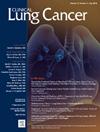Impact of Durvalumab on the Duration and Complexity of Corticosteroid Therapy for Pneumonitis After Chemoradiotherapy
IF 3.3
3区 医学
Q2 ONCOLOGY
引用次数: 0
Abstract
Introduction
It is unclear how the duration and tapering pattern of corticosteroid therapy for pneumonitis changed after the introduction of durvalumab consolidation therapy.
Methods
We retrospectively evaluated the medical records of patients diagnosed with nonsmall cell lung cancer who received chemoradiotherapy between January 2014 and December 2020.
Results
Data for 135 patients treated before durvalumab approval and 100 patients treated with durvalumab after its approval were analyzed. In both groups, more than 70% were male, with a median age of 66 y. Approximately 85% were smokers, and the most common tumor histology was adenocarcinoma. Most patients were treated with doses of 60 and 66 Gy (n = 127 [94%] vs. n = 95 [95%]). Among the patients treated with durvalumab, 57%, 38%, and 5% had grade 1, grade 2, and grade 3 pneumonitis; none had grade 4 or 5 pneumonitis. Patients treated with durvalumab exhibited a longer duration of corticosteroid therapy for pneumonitis (17 wk; range: 2-88 wk) than patients not treated with durvalumab (7 wk; range: 0.4-21 wk; P < 0.001). Pneumonitis relapse was more frequent in patients treated with durvalumab (n = 8; 23%) than in patients not treated with durvalumab (n = 2; 7%). Among the 8 patients treated with durvalumab, 2 had recurrent pneumonitis, 1 could not terminate corticosteroids.
Conclusions
Our data show that durvalumab prolongs the duration of corticosteroid therapy and increases the complexity of corticosteroid tapering patterns. This study can help manage pneumonitis caused by immune checkpoint inhibitors and other drugs used after chemoradiotherapy in routine practice and clinical trials.
Durvalumab对化疗后肺炎皮质类固醇治疗的持续时间和复杂性的影响
方法 我们回顾性评估了2014年1月至2020年12月期间接受化放疗的非小细胞肺癌患者的病历,结果 分析了在德伐卢单抗获批之前接受治疗的135例患者和获批之后接受德伐卢单抗治疗的100例患者的数据。两组患者中,70%以上为男性,中位年龄为66岁,约85%为吸烟者,最常见的肿瘤组织学为腺癌。大多数患者的治疗剂量为 60 和 66 Gy(n = 127 [94%] vs. n = 95 [95%])。在使用德伐卢单抗的患者中,57%、38%和5%的患者出现了1级、2级和3级肺炎,没有人出现4级或5级肺炎。与未使用德伐卢单抗的患者(7 周;范围:0.4-21 周;P < 0.001)相比,使用德伐卢单抗的患者因肺炎而接受皮质类固醇治疗的时间更长(17 周;范围:2-88 周)。与未使用德伐卢单抗的患者(2;7%)相比,使用德伐卢单抗治疗的患者(8;23%)肺炎复发的频率更高。结论我们的数据显示,度伐卢单抗延长了皮质类固醇的治疗时间,并增加了皮质类固醇减量模式的复杂性。这项研究有助于在日常实践和临床试验中处理化放疗后使用的免疫检查点抑制剂和其他药物引起的肺炎。
本文章由计算机程序翻译,如有差异,请以英文原文为准。
求助全文
约1分钟内获得全文
求助全文
来源期刊

Clinical lung cancer
医学-肿瘤学
CiteScore
7.00
自引率
2.80%
发文量
159
审稿时长
24 days
期刊介绍:
Clinical Lung Cancer is a peer-reviewed bimonthly journal that publishes original articles describing various aspects of clinical and translational research of lung cancer. Clinical Lung Cancer is devoted to articles on detection, diagnosis, prevention, and treatment of lung cancer. The main emphasis is on recent scientific developments in all areas related to lung cancer. Specific areas of interest include clinical research and mechanistic approaches; drug sensitivity and resistance; gene and antisense therapy; pathology, markers, and prognostic indicators; chemoprevention strategies; multimodality therapy; and integration of various approaches.
 求助内容:
求助内容: 应助结果提醒方式:
应助结果提醒方式:


